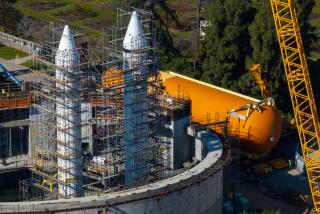770-ton load from San Onofre nuclear plant arrives at Utah disposal site
- Share via
The seven-week journey of an old but vital piece of the San Onofre nuclear power plant, a shipment weighing in at 770 tons, has been completed.
The reactor pressure vessel that helped generate electricity at Unit 1 of the plant arrived last week at a licensed disposal site about 75 miles west of Salt Lake City after being shipped by rail and then over highways in Nevada and Utah.
The removal of the vessel “is an important milestone” in the larger efforts to decommission the San Onofre Nuclear Generating Station, or SONGS, said Doug Bauder, vice president at Southern California Edison and chief nuclear officer at the facility.
“The project required detailed planning and coordination between the SONGS oversight team and our contractors,” Bauder said in an email. “From start to finish, the project was done with safety as the top priority.”
The vessel left SONGS May 24 via rail before stopping at an industrial park in North Las Vegas, Nev., where cranes helped assemble a trailer 122 feet long, with 45 axles, that slowly hauled the massive chunk about 450 miles along highways in Nevada and Utah to the EnergySolutions disposal facility in the town of Clive, Utah.
Six heavy-duty Class 8 trucks with combined 4,000-horsepower moved the load. The convoy used 460 tires that were 18 inches wide to prevent damaging roads, bridges and public infrastructure. Contractors from Emmert International used hydraulic jacks to reinforce drainage culverts.
A spokesman for the Nevada Department of Transportation said it was the heaviest load to ever traverse the Silver State’s roadways. Transportation officials in Utah said the shipment arrived July 14 without any issues.
The pressure vessel held nuclear fuel at SONGS when Unit 1 was in operation between 1968 and 1992. For 18 years, the vessel sat at the north end of the plant, covered in a shell of steel two inches thick, with a top and bottom each three inches thick to shield against radiation.
Encased in a carbon steel cylinder for the trip, the vessel contained pieces of radioactive metal and grout. The U.S. Nuclear Regulatory Commission designated the shipment as Class A low-level waste, the least hazardous classification of radioactive waste.
The shipment is one of many that will head to the Clive disposal facility as part of a scheduled eight-year process to dismantle SONGS, although future shipments will not be as large. EnergySolutions and construction giant AECOM have partnered to undertake the $4.4-billion demolition project, which began earlier this year.
The SONGS decommissioning plan is one of the nation’s largest; EnergySolutions told the Salt Lake City Tribune it expects to yield about 13.4 million cubic feet of low-level waste. The company projects that 40% to 60% of the material will be free of damaging levels of radiation.
“However, because they are present within the licensed footprint, they must be considered and treated as being radioactively contaminated until the absence of excess levels of radioactivity can be confirmed,” EnergySolutions spokesman Mark Walker told the newspaper.
If all goes as planned, by the time dismantlement at SONGS is completed, all that will remain will be two dry storage facilities holding 3.55 million pounds of used-up fuel or waste that accumulated during the time the plant produced power; a security building with personnel to look over the waste; a 28-foot-tall seawall; a walkway connecting two beaches north and south of the plant; and a switchyard with power lines.
The distinctive 200-foot-tall twin domes that loom over Interstate 5 are scheduled to come down between late 2025 and 2027.
Nikolewski writes for the San Diego Union-Tribune.
More to Read
Sign up for Essential California
The most important California stories and recommendations in your inbox every morning.
You may occasionally receive promotional content from the Los Angeles Times.














